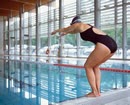 It is no secret that athletes are always looking for an edge. As an athlete hungry to improve your performance, sometimes you can only train so hard before it becomes necessary to find ways of supplementing your training. Some athletes enhance their workload through cross training, resistance training or even through taking up another sport. One tool that has emerged in the last decade which has high performance and recreational athletes, especially endurance athletes, very excited is the underwater treadmill.
It is no secret that athletes are always looking for an edge. As an athlete hungry to improve your performance, sometimes you can only train so hard before it becomes necessary to find ways of supplementing your training. Some athletes enhance their workload through cross training, resistance training or even through taking up another sport. One tool that has emerged in the last decade which has high performance and recreational athletes, especially endurance athletes, very excited is the underwater treadmill.Underwater treadmills have been used to rehabilitate injuries, as in the case of NFL player RGIII of the Washington Redskins. Running on an underwater treadmill can enable runners to add extra mileage without the shock to joints, ligaments, muscles and tendons. This extra compliment to training is a great way to build cardiovascular strength.
A study done by the University of Texas A&M examined the efficacy of water treadmill training for overweight and obese adults and concluded that using an underwater treadmill was as beneficial as running on a land treadmill. The study showed that running on an underwater treadmill improved aerobic fitness and body composition for inactive and overweight individuals. Interestingly, underwater treadmills were seen to increase lean muscle mass in the legs at a greater rate compared to running on a land treadmill. Another study concluded that underwater treadmill running was a viable alternative to maintaining cardiovascular fitness without the demands of running on land.
Benefits of an under water treadmill
- Maintains or enhances performance
- Reduces the risk of injuries since there is less stress on the body
- Used as a rehabilitation tool for injury
- Adds extra mileage without the shock to joints, ligaments, muscles and tendons.
 Whether you are rehabbing an injury, cross training or working to maintain your cardiovascular fitness, an underwater treadmill can be a great form of training without incurring the wear and tear associated with pounding the pavement. From the high performance athlete who needs to rehabilitate or add extra mileage without the added risk of running on land, to the recreational athlete working to maintain fitness or lose weight, the underwater treadmill can be a valuable tool.
Whether you are rehabbing an injury, cross training or working to maintain your cardiovascular fitness, an underwater treadmill can be a great form of training without incurring the wear and tear associated with pounding the pavement. From the high performance athlete who needs to rehabilitate or add extra mileage without the added risk of running on land, to the recreational athlete working to maintain fitness or lose weight, the underwater treadmill can be a valuable tool.This technology is still relatively new. Finding an underwater treadmill in your area may require some diligence and research on your part. The benefits of running underwater however may make the search more than worth it.
References from the SIRC Collection:
1. Brubaker P, Ozemek C, Gonzalez A, Wiley S, Collins G. Cardiorespiratory Responses During Underwater and Land Treadmill Exercise in College Athletes. Journal Of Sport Rehabilitation. August 2011;20(3):345-354.
2. Denning W, Bressel E, Dolny D, Bressel M, Seeley M. A Review of Biophysical Differences Between Aquatic and Land-Based Exercise. International Journal Of Aquatic Research & Education. February 2012;6(1):46-67.
3. Hall J, Macdonald I, Maddison P, O'Hare J. Cardiorespiratory responses to underwater treadmill walking in healthy females. European Journal Of Applied Physiology & Occupational Physiology. February 1998;77(3):278-284.
4. HUTCHINSON A. Go Low Impact. Runner's World. October 2013;49(10):38.
5. Schaal C, Collins L, Ashley C. Cardiorespiratory Responses to Underwater Treadmill Running Versus Land-Based Treadmill Running. International Journal Of Aquatic Research & Education. February 2012;6(1):35-45.
6. Stevens S, Morgan D. Guest Editorial. Underwater treadmill training in adults with incomplete spinal cord injuries. Journal Of Rehabilitation Research & Development. October 2010;47(7):vii-xi.
No comments:
Post a Comment